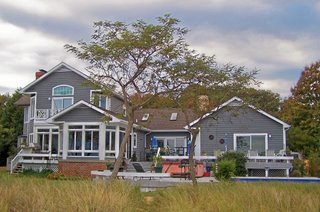Light Done Right !
Lighting can do wonders for the look and feel of a home, both inside and out. Get tips on setting an inviting mood and showing off your home's best features.BY BARBARA BALLINGERArtificial lighting does more than brighten a dark room. It sets a mood, draws the eye to special architectural details, and makes a home’s entrance inviting long after the sun has set. Then there’s the decorative angle. With bulbs housed in big colorful paper lanterns, dangly crystal chandeliers, or crisp modern glass pendants, lighting also can be a focal point on its own.
Lighting offers yet another plus: When done right, it helps you showcase your home’s best features and speeds a sale. In this column, you’ll learn about the various styles of lighting fixtures for indoors and outdoors, and get tips on how to use lighting to your greatest advantage when selling a property.
Illuminating VocabularyFirst, know how to speak the lighting language. These are the basic lighting terms to know when talking lighting:
Lamp. The light source, sometimes called a light bulb, which can be incandescent, fluorescent, or halogen. Lamps come in a range of colors and wattages.
Incandescent lamp. The most widely used source of illumination for the home, invented by Thomas Edison. It’s inexpensive and can be dimmed, but is inefficient. Light is produced by means of an element heated to the point of incandescence.
Fluorescent lamp. More energy efficient than an incandescent, it comes in many wattages, colors, shapes, and can be dimmed, if it has a dimmable ballast in the unit and a fluorescent dimmer control.
Halogen lamp. An incandescent lamp that contains halogen gases, it offers a crisp white beam, but is more expensive than an incandescent.
LED. A new light source, the light-emitting diode comes as a tiny bulb, gives off little heat, is more energy efficient than a fluorescent, lasts 50,000 to 100,000 hours, and comes in various colors. Downsides: These lights can be expensive, though the price is dropping, and they can be harder to find than regular bulbs.
Compact fluorescent (CFL). Although expensive, these fluorescent lamps conserve energy, last up to 10,000 hours, and have a high-quality color rendering capability, but are still pricey, though less than LEDs.
Light fixture. A complete lighting unit that includes a lamp, a sometimes decorative housing for the lamp, and a connection to the source of electrical power.
Rather than choosing lighting fixtures after a house is built or remodeled, design experts advise home owners plan their lighting look from the get-go so that lighting fixtures will fit in seamlessly with the rest of the home. Built-in lighting may be costly, but it’s worth it, experts say. Retail lighting showrooms offer an advantage. Many of them have lighting labs, which are room-like vignettes showing how lighting will really look, and are staffed by consultants who will help home owners develop a master lighting plan, sometimes for no fee if purchases are made. Creating a Finished, Sparkling LookThe best lighting plans include three layers: general or ambient lighting that illuminates the entire space; mood lighting to create a special glow in designated areas; and task or accent lighting to play up architectural details, furnishing, or art.
“Lighting makes rooms breathe, adds drama, magic, and romance — and makes home owners feel comfortable,” says New York lighting and furniture designer Sergio Orozco. To decide how much light to use and where to use it, home owners should decide what tasks they’ll perform and what features they want to accent, Orozco says. You also should keep that advice in mind when prepping a home for sale; highlight areas of the home in which you’d like buyers to envision themselves going about daily life. Task lighting can turn attention to a granite countertop or an undermount sink, while accent lighting can make the Colonial-style fireplace stand out.
Here are some more indoor lighting tips from Orozco:
Use a consistent style. Factor in the style of décor and home’s architectural detailing. An elaborately decorated dining room may look better with a period crystal chandelier than a trio of funky colorful pendants
.
Be task-specific: Lighting should be selected for tasks at hand. To see a computer screen well, for instance, place lighting behind the monitor so it’s not reflected on the monitor.
View rooms at night. Before making a lighting purchase, know what the room looks like at night, without any natural light.
Try sconces. Consider wall sconces when trying to create an elegant, romantic effect.
Don’t forget the cover-up. Be sure all fixtures have some type of cover so a bulb isn’t visible.
Use individual switches. Install several switches to control lights individually. Don’t forget dimmers.
Light Up the Outdoors. One easy way to expand a home: Make the backyard and deck visible from the house, even at night. Outdoor lighting can accent pools, gardens, trees, walkways, and entryways. Safety is an added bonus.
He also offers these tips for making a big impact outdoors:
Be selective. Rather than light up the entire yard, select a few features to highlight. Shy away from floodlights. Instead, use soft lighting that mimics the moon on a clear night.
Conceal the source. Whenever possible, choose and install outdoor lighting before landscaping is completed so transformers and wires can be concealed. Even if you don’t plan ahead, you should try to safely hide the lighting behind shrubs or bushes so the fixture isn’t apparent — unless it’s a decorative fixture, of course.
Protect against the weather. Select weather-resistant aluminum products.
For flexibility, go portable. Portable lights can be moved throughout the yard whenever you want. One day you can light up a pathway to the gazebo, the next day you can focus on the garden.
Experiment. Think about aesthetics and how different types of plants look in artificial light. It can be difficult to judge, so experiment by placing fixtures in different spots.
Among the hottest new trends:
Tiny lights. Miniature recessed lighting uses MR11 or MR16 low-voltage halogen lamps to illuminate ceilings, shelving, and more. The diameter of these fixtures is less than 3 inches.
Deep finishes. Oil-rubbed bronze, brown, and silver are popular finishes.
Ultra-modern chandeliers. Metal fixtures in modern shapes are hot sellers.
Familiar shapes. Simple geometric lamp shades with beading, embroidery, or fringe.
Pretty stains. Tea-stained glass for pendants and chandeliers is replacing alabaster-colored glass.
I know this was a long article, but think the information is really important for home selling and market preparation...Have a Great Day! Chris

 Housing markets predicted to RISE!
Housing markets predicted to RISE!

